GREAT BARRIER REEF : Still Colourful Corals and Curious Fish
Posted: October 1, 2020 | Author: Jamie Spry | Filed under: Alarmism Debunked, Alarmist media, Climate Alarmism, Climatism, Coral Bleaching, Education, Fact Check, Great Barrier Reef | Tags: Cairns, Climate Change, Climatism, Clint Hempsall, Coral Bleaching, Dr Jennifer Marohasy, Global Warming, Great Barrier Reef, IPA, JCU, nature, Ribbon Reef, science, Terry Hughes | 3 Comments
“BLIND trust in authority
is the greatest enemy of the truth.”
– Albert Einstein
***
AS many of you may have read from twitter, I’ve decided to back-off, temporarily, from the constancy of battle against the Left’s ideological crusade against science and reason, in favour of completing my degree in psychology/counselling. A modality that will, most probably, be in ‘yuge’ demand in the coming years, following the Left’s most recent assault on your freedoms and existence, COVID-19. A mutation of the common coronavirus that just happens to fall in a US election year. A natural mutation that has a survival rate of 99.97% (globally). In my country, Australia, the average age-of-death-by-covid is 83. The average age of mortality in Australia is 82, and yet, in Victoria, we are suffering the most draconian lockdown measures in-the-world. The mind boggles…unless you’re a socialist, of course.
SO, in an effort to soothe our collective wounded COVID souls, at the same time, help soothe the ails of the constant barrage of impetuous climate alarmism, set aside twelve minutes of your precious time to view some of the incredible work done by (GBR-climate-science-hero) Jennifer Marohasy, as she documents, with Emmy Award winning cameraman Clint Hempsall, the pristine, Great Barrier Reef, for all to marvel.
Enjoy and best,
Jamie
***
Via Email (1/10/20)
(Climatism bolds)
via Dr Jennifer Marohasy
Researcher, Writer & Filmmaker

Keeping You in the Loop
Many of the media headlines that give the impression the Great Barrier Reef is a ruin are based on aerial surveys by one man. The same Terry Hughes who incorrectly claimed the inshore reefs off-Bowen are now mud-flat. Paid not by an oil company, but rather the long-suffering Australian taxpayer through generous research grants, he gets to sit in a light aircraft and fly at about 300 metres altitude every few years and determine (by looking out the window) that the corals are badly bleached.
Hughes is a myth maker. The Great Barrier Reef is still beautiful. There are still colourful corals and curious fish.
Earlier this year, I went to the Ribbon reefs with Emmy Award winning cameraman Clint Hempsall in search of death and bleaching. Instead we found so much life as I explain in my second short film, just yesterday uploaded to a new page at the Institute of Public Affairs’ website:
Great Barrier Reef
The short film will only take 12 minutes of your time. The music was all composed by local Noosa guitarist Mungo Coats.
At the Ribbons, in January, the waters were so warm, the corals so colourful and the fish not at all frightened of me. In fact, as you will see in the film – a giant cod fish looked me in the eye, and more than once! He came back to me, again and again. We swam together. It was magical.
For me, the Ribbons at the Great Barrier Reef, are the most special and awe-inspiring place on this planet. I was so privileged to dive them with Clint Hempsall and so much thanks to Mungo Coats for putting it all to music.
Great Barrier Reef
Thanks for caring.
Sincerely,
Dr Jennifer Marohasy
Researcher, Writer & Filmmaker
*
What is the true state of the Great Barrier Reef? If you asked most Australians, they’d say the Great Barrier Reef is at risk of imminent collapse from climate change. It was for questioning this claim, and the quality of science behind it, that eventually led to Dr Peter Ridd being sacked from James Cook University.
In January 2020, Emmy Award winning cameraman Clint Hempsall, and IPA Senior Fellow Jennifer Marohasy decided to find out. They spent a week exploring the Ribbon Reefs 250kms to the north east of Cairns in search of coral bleaching – the process of corals turning white as a result of warmer water temperature, which climate scientists say is being caused by climate change. Some argue 60% of the coral at the Ribbon Reefs was irretrievably bleached in 2016.

If there was extensive bleaching back then, Jennifer and Clint couldn’t find much evidence of it in January this year. What they did find was healthy corals, curious clown fish, a giant potato cod, reef sharks, and an underwater cave. Indeed, much of the coral Clint filmed was growing vertically and would thus be invisible to the aerial surveys underpinning the bleaching scare.
The Ribbon Reefs have coral gardens hanging over underwater cliff-faces that drop 2,000 metres to the sea floor – all washed over twice a day by the warm waters of the South Pacific. There are ten such coral reefs in far north Queensland where they grow over the top of the north eastern edge of Australia’s continental shelf.

•••
GBR Related :
- ALARMISTS U-TURN : Scientists Confirm Great Barrier Reef Is Recovering From Bleaching, Again | Climatism
- GREAT BARRIER REEF SCIENTIST : Coral Can Take The Heat, Unlike ‘Experts’ Crying Wolf | Climatism
MORE GBR :
- GREAT BARRIER REEF Hysteria : Exaggerated Claims And Blatant Falsehoods, Designed To Spread Fear And Belief In A Man-Made Climate Apocalypse | Climatism
- THE Great Barrier Reef is thriving, not dying! (local experts / dive-boat operators) | Climatism
- Great Barrier Reef Expert : Don’t Trust Climate Alarmists | Climatism
- Great Barrier Reef in near pristine condition: dive boat operators | Climatism
- “Dying” Reef Actually Growing | Climatism
- UNESCO ‘Green’ Lights The Reef – Activists Exposed As Liars And Frauds | Climatism
- Not Dead Yet: Great Barrier Reef Coral Cover Up 19 Per Cent In Three Years | Climatism
GBR Must Read :
- Falling Sea Level: The Critical Factor in 2016 Great Barrier Reef Bleaching! | Climatism (MUST READ)
•••
THE Climatism Tip Jar – Support The Fight Against Dangerous, Costly and Unscientific Climate Alarm
(Climate sceptics/rationalists still waitin’ for that “big oil” cheque to arrive in the mail!)
Help us to hit back against the bombardment of climate lies costing our communities, economies and livelihoods far, far too much.
Thanks to all those who have donated. Your support and faith in Climatism is highly motivating and greatly appreciated!
Citizen journalists can’t rely on mastheads, rather private donations and honest content.
Click link for more info…
Many thanks, Jamie.

(NB// The PayPal account linked to “Climatism” is “Five-O-Vintage”)

•••
MASSIVE Victory For Climate Change Realism And Academic Freedom!
Posted: April 16, 2019 | Author: Jamie Spry | Filed under: Australia, Climate Change, Climatism, Great Barrier Reef, Sceptics | Tags: Climate Change, Climate Change Hoax, Climatism, Global Warming, Great Barrier Reef, James Cook University, JCU, Peter Ridd, pseudoscience, Scepticism is Science, science, Science and Environment | 2 Comments
James Cook professor’s sacking ruled ‘unlawful’ | The Australian
“BLIND trust in authority
is the greatest enemy of the truth.”
– Albert Einstein
***
A BIG WIN for freedom of speech and academic freedom as former JCU Great Barrier Reef expert, Peter Ridd, wins wrongful dismissal case against James Cook ‘University’.
ALSO, a massive win for climate scepticism and the fight against sloppy, pseudoscientific ‘science’ driven by Leftist dominated academia driving the $2,000,000,000,000 US per year (2 Trillion) man-made global warming climate change agenda.
*
via The Australian :
James Cook professor’s sacking ruled ‘unlawful’
A Federal Court judge has ruled that James Cook University acted unlawfully when it sacked professor Peter Ridd after he publicly criticised the institution and one of its star scientists over claims about the impact global warming had on the Great Barrier Reef.
Professor Ridd, who worked at the university for 40 years, challenged the dismissal in the Federal Circuit Court, saying the university breached its own enterprise agreement which allowed all staff to express controversial or unpopular views.
The physics professor argued that the Townsville-based university, which is renowned for its marine science expertise, dismissed him for breaching the university’s code of conduct.
Handing down his decision today, judge Salvatore Vasta said that the 17 findings used by the university to justify the sacking were unlawful.
“The Court rules that the 17 findings made by the University, the two speech directions, the five confidentiality directions, the no satire direction, the censure and the final censure given by the University and the termination of employment of Professor Ridd by the University were all unlawful,” Judge Vasta said.
A penalty hearing will be set for a later date.
At a hearing last month, Professor Ridd’s barrister Stuart Wood argued his client was entitled to criticise his colleagues and the university’s perceived lack of quality assurance processes.
In 2016, Professor Ridd emailed a journalist to allege that images given to the media by the Australian Institute of Marine Science and Great Barrier Reef Marine Park Authority were misleading because they showed poorly affected corals, which were selected over nearby healthy coral and used to show “broad scale decline” of reef health.
Professor Ridd claimed the use of the images was “a dramatic example of how scientific organisations are happy to spin a story for their own purposes”.
He also said his colleague Professor Terry Hughes, the head of JCU’s Centre of Excellence for Coral Reef Studies, would “wriggle and squirm” when asked to explain the discrepancies in the images.
Professor Ridd was censured again when he repeated the claims on Sky News.
After a third alleged violation of the code of conduct, Professor Ridd was sacked in April 2018.
***
RELATED :
- ALARMISTS U-TURN : Scientists Confirm Great Barrier Reef Is Recovering From Bleaching, Again | Climatism
- GREAT BARRIER REEF SCIENTIST : Coral Can Take The Heat, Unlike ‘Experts’ Crying Wolf | Climatism
GREAT BARRIER REEF related :
- GREAT BARRIER REEF Hysteria : Exaggerated Claims And Blatant Falsehoods, Designed To Spread Fear And Belief In A Man-Made Climate Apocalypse | Climatism
- THE Great Barrier Reef is thriving, not dying! (local experts / dive-boat operators) | Climatism
- Great Barrier Reef Expert : Don’t Trust Climate Alarmists | Climatism
- Great Barrier Reef in near pristine condition: dive boat operators | Climatism
- “Dying” Reef Actually Growing | Climatism
- UNESCO ‘Green’ Lights The Reef – Activists Exposed As Liars And Frauds | Climatism
- Not Dead Yet: Great Barrier Reef Coral Cover Up 19 Per Cent In Three Years | Climatism
A GBR Must Read :
- Falling Sea Level: The Critical Factor in 2016 Great Barrier Reef Bleaching! | Climatism (MUST READ)
STATE Of The Climate Report :
IPCC Extreme Weather Report 2018 SR15 :
TEMPERATURE Related :
- JAPAN ACKNOWLEDGES THE GLOBAL WARMING ‘PAUSE’ : Sanctions 35 New Coal Power Plants Added To The 100 Currently Operational | Climatism
- THE Great Global Warming “Pause” | Climatism
- GLOBAL Temperature Drops By 0.4°C In Three Years | Climatism
- PEER-REVIEWED SCIENCE : The Medieval Warm Period Was Indeed Global And Warmer Than Today | Climatism
- THE SUN : Climate Control Knob, Enemy Of The Climate Cult | Climatism
- THE SUN : Climate Changer, Climate Driver, Climate Disruptor | Climatism
ORIGINS Of The Global Warming Scam :
- DRACONIAN UN CLIMATE AGENDA EXPOSED : ‘Global Warming Fears Are A Tool For Political and Economic Change…It Has Nothing To Do With The Actual Climate’ | Climatism
- THE Catastrophic Anthropogenic Global Warming Scam | Climatism
- CLIMATE CHANGE : The Unsettled Science Of “Settled” Science | Climatism
- FATHER Of The 2°C Climate Target Admits Number Is Fabricated : ‘Two degrees is not a magical limit; it’s clearly a political goal’ | Climatism
- TIM FLANNERY – Professor of Dud Predictions and Climate Falsehoods | Climatism
- THE Mind-blowing Costs Of Global Warming Hysteria | Climatism
- THE Orwellian Era Of @NASA Climate Pseudoscience | Climatism
- WESTERN Nations, Driven By A Global Agenda Of Climate Alarmism, Are Destroying Their Industries With Carbon Taxes And Promotion Of Expensive, Intermittent Green Energy | Climatism
- TOMORROW’S Grim, Global, Green Dictatorship | Climatism
- CLIMATE CHANGE – The Most Massive Scientific Fraud In Human History | Climatism
- “In Searching For A New Enemy To Unite Us, We Came Up With The Threat Of Global Warming” | Climatism
- The Creator, Fabricator And Proponent Of Global Warming – Maurice Strong | Climatism
- Global Warming Is The Greatest And Most Successful Pseudoscientific Fraud In History | Climatism
- Sustainability is Malthusianism for the 21st Century | Climatism
- THE Climate Change Farce Explained By Two Expert “Scientists” | Climatism
- UN IPCC : Climate “Has Almost Nothing To Do With Environmental Policy.” | Climatism
- UN IPCC : “Long-Term Prediction of Future Climate States Is Not Possible.” | Climatism
- UN IPCC Rewrote Temperature History To Suit Their Political Agenda | Climatism
- 100% Of Climate Models Prove That 97% Of Climate Scientists Were Wrong! | Climatism
- YES! The Climate Changes | Climatism
- OUR Planet Has Enjoyed 10 Warm Periods During The Past 10,000 Years | Climatism
- THE ARCTIC : Ground Zero For Anthropogenic Hubris And Climate Change Hysteria | Climatism
•••
THE Climatism Tip Jar – Pls Help Keep The Good Fight Alive!
(Climate sceptics/rationalists still waitin’ for that “big oil” cheque to arrive in the mail!)
Help us to hit back against the bombardment of climate lies costing our communities, economies and livelihoods far, far too much.
Thanks to all those who have donated. Your support and faith in Climatism is highly motivating and greatly appreciated!
Citizen journalists can’t rely on mastheads, rather private donations and honest content. Every pledge helps!
Click link for more info…
Thank You! Jamie.

•••
HEART of A Nation: Cockatoo Reef, Queensland
Posted: February 3, 2019 | Author: Jamie Spry | Filed under: Alarmist media, Australia, Climatism, Coral Bleaching, Great Barrier Reef, Green Agenda, Ocean Acidification | Tags: Activist Media, Australia, Climate Change, Climatism, Cockatoo Reef, Coral Bleaching, Global Warming, Great Barrier Reef, Mainstream media, nature, Ocean Acidification, Peter Hannam, Science and Environment | Leave a comment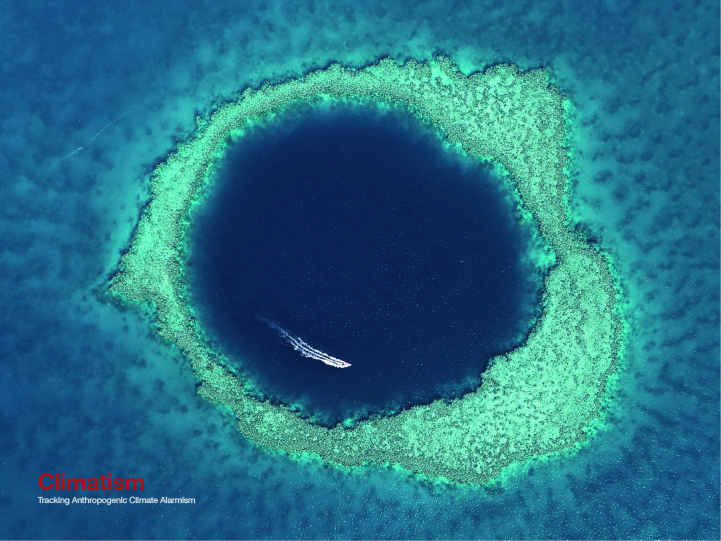
Cockatoo Reef Blue Hole, Great Barrier Reef. Picture: Johnny Gaskell
“CLIMATE alarmism is a gigantic fraud: it only survives by suppressing dissent and by spending tens of billions of dollars of public money every year on pseudo-scientific propaganda.” – Leo Goldstein
“TO tell preposterous untruths in this ‘good’ cause
is not just forgivable but a sign of superior morality.
The bigger the whopper the more you must really care.”
– Andrew Bolt
***
AUSTRALIA’s Great Barrier Reef, all-too-often garners the attention of the mainstream media for all the wrong reasons. It has long been a favoured icon of the $2,000,000,000,000 US per year (2 Trillion) Climate Crisis Industry used to push their draconian, CO2 Climate Change agenda. How dare we actually get to enjoy the Reef’s overwhelming pristine beauty!
WHILE protection of the reef is a no-brainer, the ludicrous scaremongering by global warming activists about the “dying” reef is costing Australians jobs and money:
THREE surveys conducted in Britain, China, and the United States, have shown citizens in those countries – when the situation is raised with them – say that are concerned that the world-renowned reef is under severe threat. And many would reconsider visiting as a result…
An estimated 175,000 fewer tourists could visit Australia if the bleaching persists and worse if the [claimed] damage becomes permanent.
The polls, which surveyed the attitudes and awareness of 1000 people in each market, found potential visitors were concerned over the state of the reef, which in turn could feed into them deciding to visit other Australian attractions or to go to places other than Australia entirely.
The finding suggests the tourism businesses and related local economies adjacent to the Great Barrier Reef, could suffer the loss of 10,000 jobs and that the Australian economy could lose as much as $1 billion per year in overseas income.
The reef supports an estimated 70,000 jobs in the tourism and related sectors and accounts for a significant proportion of Australia’s tourist income.
Great Barrier Reef Scaremongers Risk 10,000 Jobs | Climatism
*
COCKATOO REEF is a piece of the reef that the climate change zealots haven’t yet spoiled with a government grant or a pal-reviewed acid-attack. And is yet to be sullied by the panicked-pen of Sydney Morning Herald’s climate catastrophist-in-chief Peter Hannam.
SO, enjoy the Cockatoo blue hole in all its glory, before it’s put on the threatened species list by the CO2-centrics and mainstream media hacktivists.
***
Blue hole thinking
Getting to this remote sinkhole in the Great Barrier Reef was a mission. And what marine biologist Johnny Gaskell found in it blew him away…
By ROSS BILTON

Cockatoo Reef Blue Hole, Great Barrier Reef. Picture: Johnny Gaskell
From The Weekend Australian Magazine February 1, 2019
Johnny Gaskell’s fascination with the blue holes of the Great Barrier Reef began when he was hunched over his computer one night in 2017. The marine biologist, tasked with finding coral colonies that might have escaped the ravages of Cyclone Debbie, was poring over satellite images on Google Maps when he noticed a weird anomaly — a circular indigo spot — in Cockatoo Reef, part of the remote Pompey Complex 200km off Mackay. All he could find about it online was a 1979 scientific paper that confirmed it was a marine sinkhole (you’ll have seen pictures of terrestrial versions, swallowing up entire houses) and one of a handful in the Great Barrier Reef. It gave Gaskell an idea: might these deep holes, protected from storms, harbour undamaged coral?
His first exploratory trip, to a blue hole near his base on Daydream Island in the Whitsundays, confirmed this hunch. And not only was the coral pristine, it was unlike anything he’d seen before: over decades in the 30m-deep, perfectly still water it had developed “very delicate, elongated, spindly branches” that looked like abstract sculptures. He found himself wondering, Why aren’t these blue holes better known?
Last November, the answer became clear when he finally made it out to the Pompey Complex to dive the Cockatoo Reef blue hole and two others. A 12-hour boat trip offshore, it’s a treacherous area: huge tides race through the reef channels, and even modern charts mark sections as “Unsurveyed”. Gaskell, 37, had to wait for slack water during a neap tide to thread his tender through Cockatoo Reef to its 220m-wide blue hole, a little oasis of perfect calm. He snapped this shot with a drone.
Such adventures are a far cry from his childhood in central Victoria, studying critters that he’d scoop out of creeks with a jam jar. Next winter he’s planning to visit another, unnamed blue hole hinted at in that 1979 paper — the most remote and mysterious one yet. “Legend has it it’s 70m deep,” he says. What does he expect to find? “Who knows? Big sharks,” he laughs.
Heart of the Nation: Cockatoo Reef, Queensland | Weekend Australian
•••
SEE also :
- ALARMISTS U-TURN : Scientists Confirm Great Barrier Reef Is Recovering From Bleaching, Again | Climatism
- GREAT BARRIER REEF SCIENTIST : Coral Can Take The Heat, Unlike ‘Experts’ Crying Wolf | Climatism
CLIMATISM : 2019 State Of The Climate Report
Posted: January 17, 2019 | Author: Jamie Spry | Filed under: Antarctic, Arctic, Climatism, Empirical Evidence, Extreme Weather, Fact Check, Floods, food production, Global Temperature, Grand Solar Minimum, Great Barrier Reef, Hurricanes, Pacific Island Nations, Satellite Data, Sea Level Rise, Snow Pack, State Of The Climate, The Pause | Tags: antarctic, arctic, carbon dioxide emissions, climate, Climate Change, Climate science, Climatism, CO2, drought, Extreme weather, floods, food production, Global Warming, Grain crops, Grand Solar Minimum, Great Barrier Reef, Green New Deal, Kiribati, nature, Pacific Island Nations, Polar Bears, science, sea level rise, Sea Levels, snow, State Of The Climate, Tuvalu | 10 Comments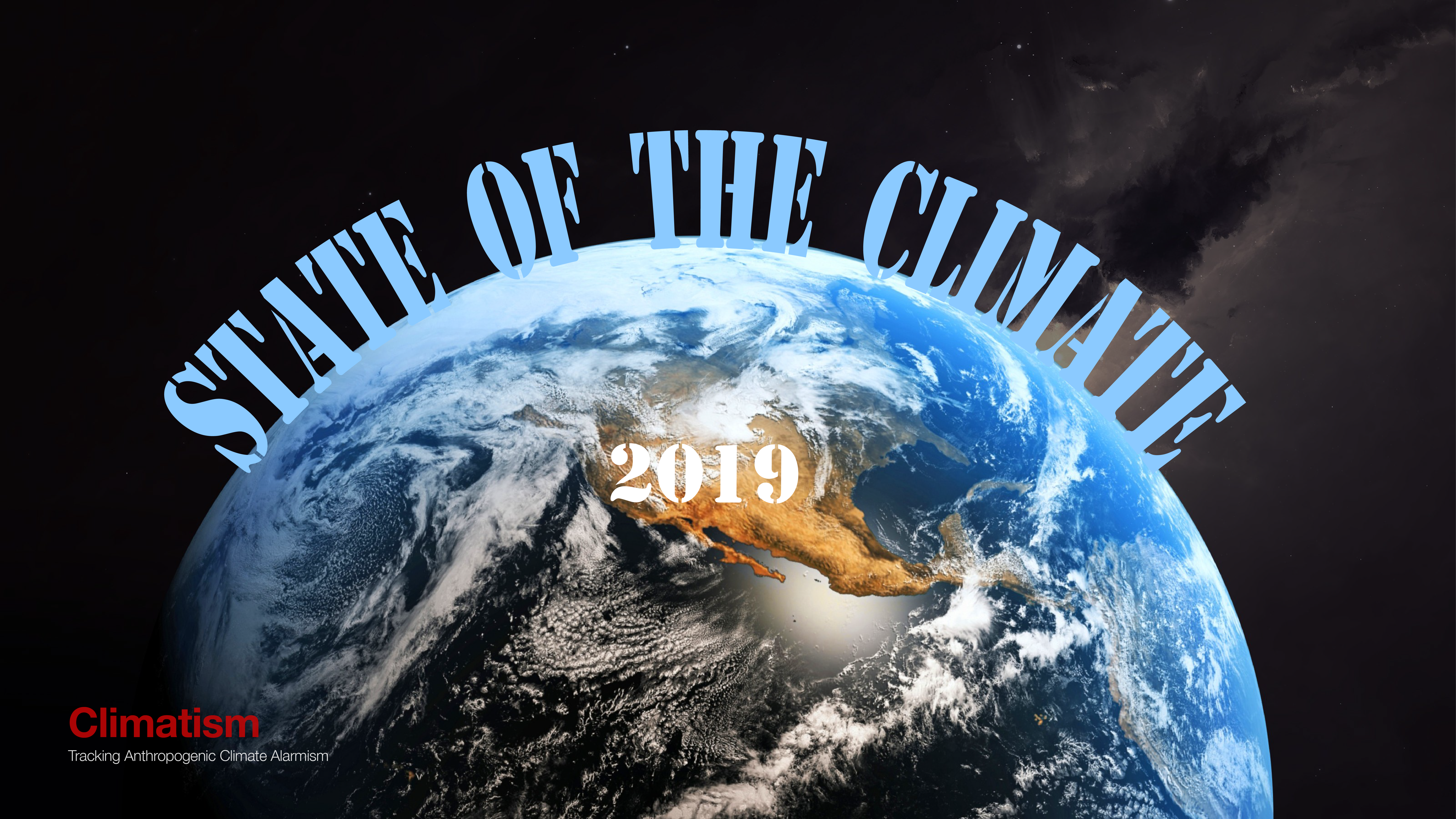
CLIMATISM – 2019 State Of The Climate Report
CONTRARY to popular thinking and clever marketing, there is no “consensus” on the theory of dangerous man-made climate change. Too many variables exist within the climate system to allow for certainty of future scenarios.
THIS doesn’t deter the $2,000,000,000,000 US per year (2 Trillion) Climate Crisis Industry who manufacture catastrophic climate scenarios (pushed far enough into the distant future as to not be held accountable) with a guarantee of climate calamity unless their utopian ‘green’ dreams are realised.
BUOYED by their recent House Congress win in the 2018 mid-term elections, the hard-Left of the American Democrat party, led by pinup-socialist Rep. Alexandria Ocasio-Cortez, have doubled-down on their pet global warming theory, proposing the radically-dystopian climate agenda, a Green New Deal.
ACCORDING to PJMedia, the Green New Deal will cost approximately $49.109 Trillion in the first ten years, enough to fund Trump’s border wall 8,616 times over.
FOR all the economic pain and social upheaval that inevitably ensues when draconian climate policy is enacted, it is only fair and reasonable for the taxpayer to ask one simple question about a climate which demands so much of their hard-earned money – “what is broken?”.
THE best way to answer this is to look at the current state of a set of common environmental metrics and analyse their relationship with carbon dioxide – the colourless, odourless, tasteless trace gas at the centre of the supposed “climate crisis”.
CLIMATE CHANGE METRICS
- ARCTIC
- ANTARCTIC
- EXTREME WEATHER (Heatwaves, Cyclones, Hurricanes, Tornadoes, Drought, Floods)
- SEA LEVELS
- SNOW
- POLAR BEARS
- WILDFIRES
- GLOBAL GREENING
- GLOBAL FOOD PRODUCTION
- GLOBAL TEMPERATURE
IN the interests of “cherry-picking”, there are a myriad of environmental metrics that make up the climate system. The examples cited for the purpose of this report are the more common associations picked up by the press and interest groups to facilitate climate change discussion and ‘debate’.
*THE empirical evidence featured in this post is taken from the latest data supplied by government scientific agencies and peer-reviewed studies. Hyper and direct links supplied per sample.
***
ARCTIC
STATE OF ARCTIC SEA-ICE : 2018 SUMMER MINIMUM
ARCTIC SEA-ICE EXTENT (September 2018)
MINIMUM sea-ice extent has been trending up over the past decade. The EXACT opposite of what the press and ‘97% experts’ have been telling you :
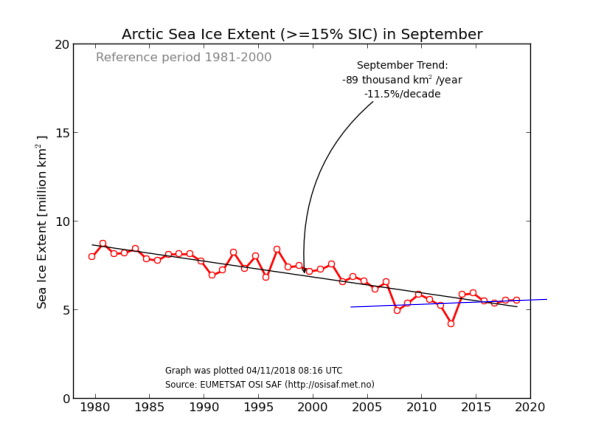
Ocean and Ice Services | Danmarks Meteorologiske Institut | September Minimum Extent
*
ARCTIC SEA-ICE EXTENT TO DATE
ARCTIC sea-ice extent is very close to the 1981-2010 median:
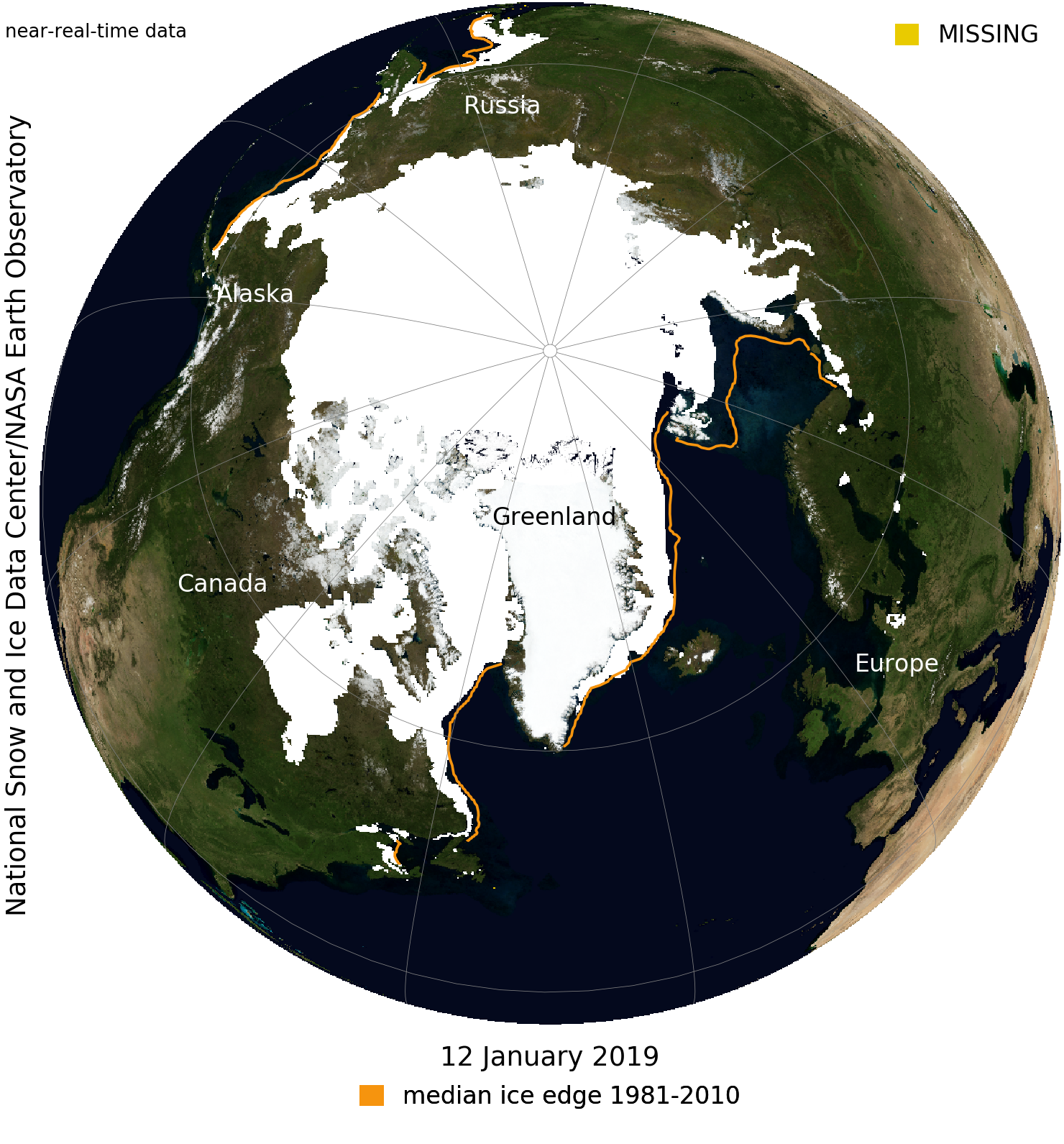
Sea Ice Index | National Snow and Ice Data Center
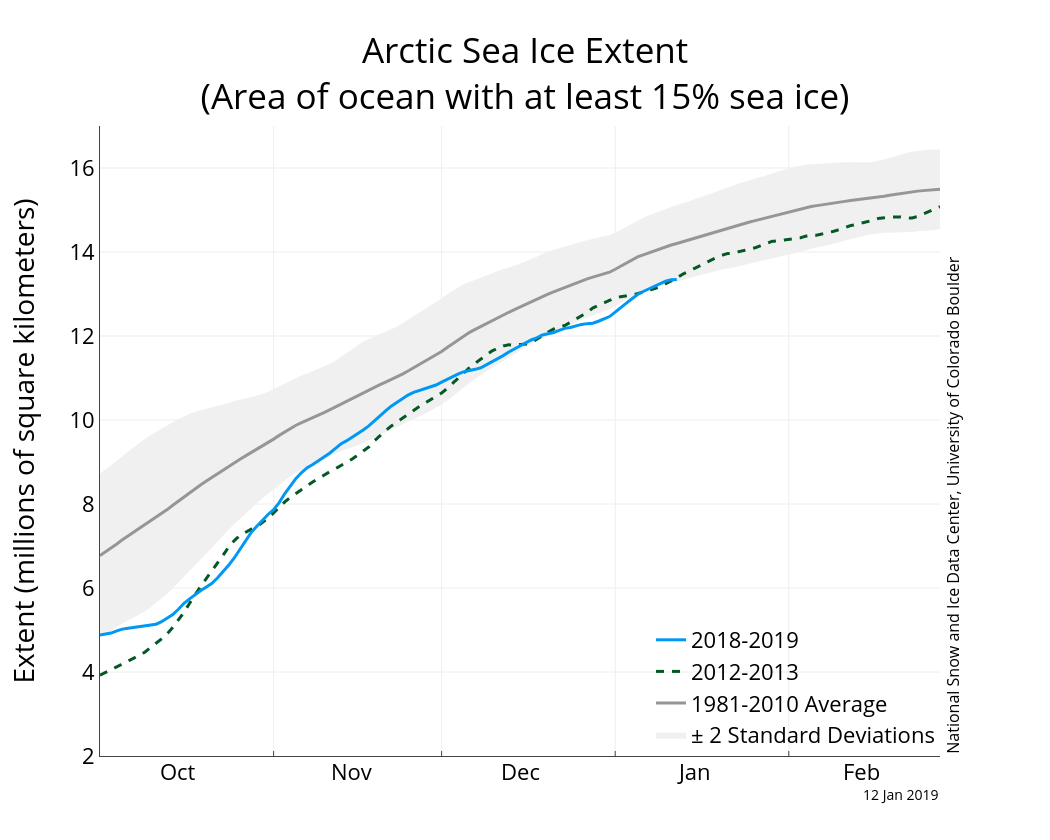
Sea Ice Index | National Snow and Ice Data Center
ARCTIC sea-ice extent is essentially unchanged since January 2006:

Spreadsheet Data
- *
ARCTIC SEA-ICE VOLUME
THE area of the Arctic covered with thick sea ice has greatly expanded over the past eleven years:
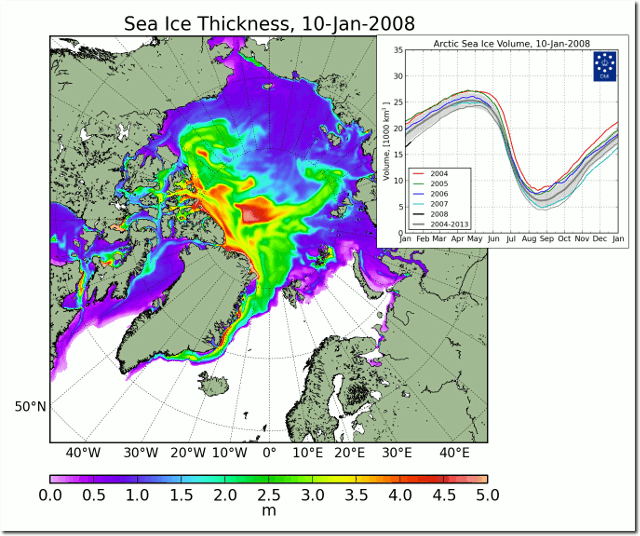
2008 2019
SO far this month, ice volume gain has seen a record high:
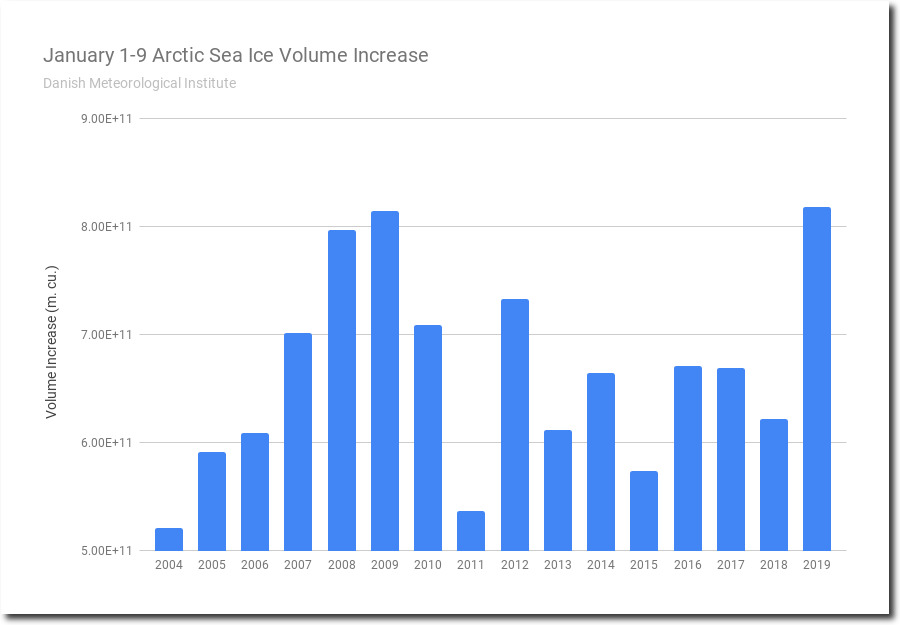
Jan Arctic Sea-Ice Volume gain historic
AND January 9 Arctic sea ice volume has been increasing for over a decade:
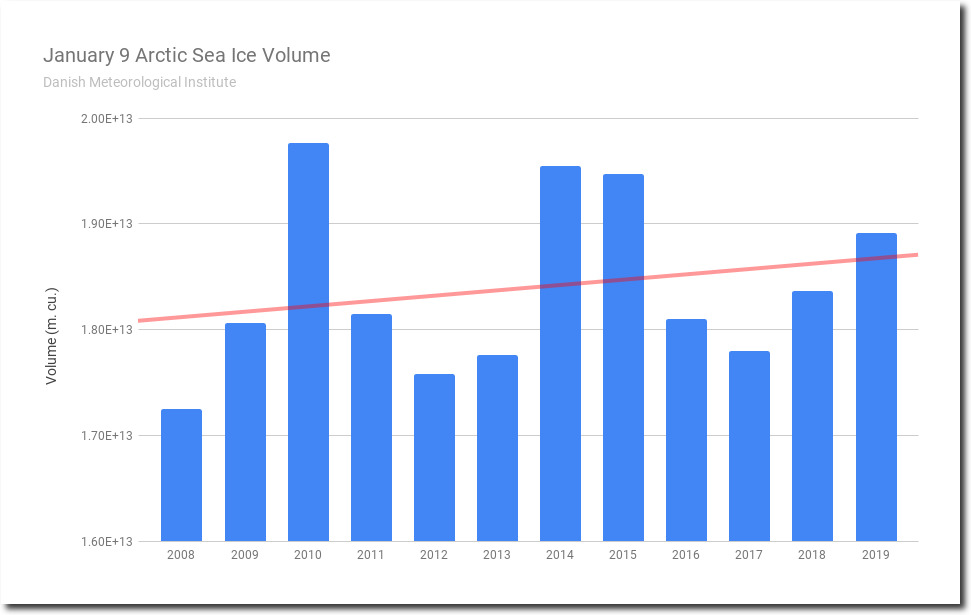
Spreadsheet Data
*Support data Via Real Climate Science
MINIMUM sea-ice volume has been rising since 2007:
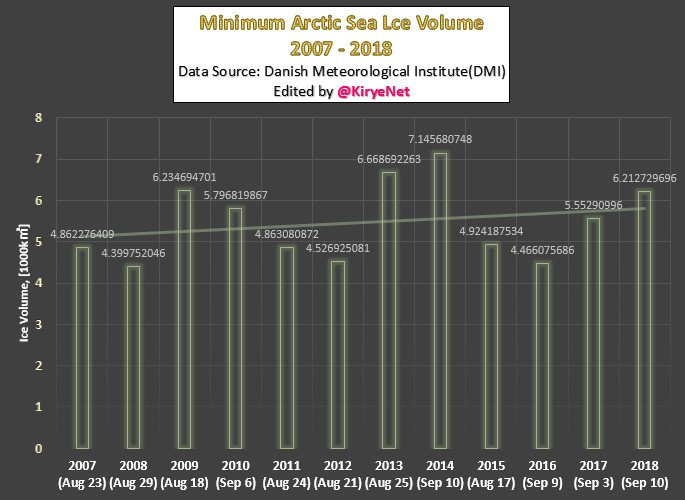
@KiryeNet キリエ on Twitter : “The Arctic has been refreezing for 12 years…minimum sea ice volume has been rising since 2007”
*
ARCTIC TEMPS
ARCTIC temperatures correlate almost perfectly with ocean circulation cycles, and show no correlation with atmospheric CO2 levels.
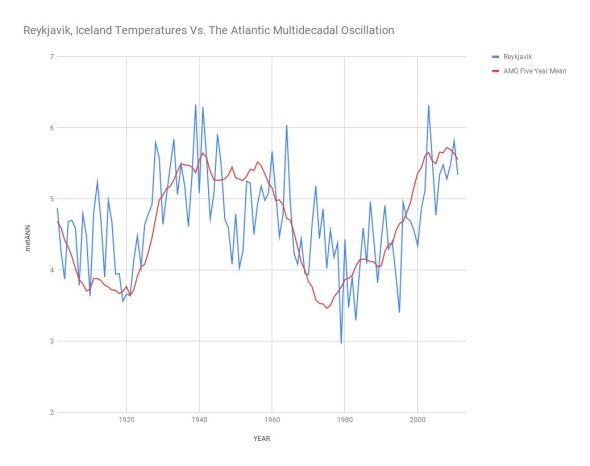
Reykjavik, Iceland Temperatures Vs. The Atlantic Multidecadal Oscillation
*
ALARMIST MAINSTREAM MEDIA ARCTIC HYSTERIA
CLIMATE ‘experts’ describe these record large increases in ice as an unprecedented meltdown:
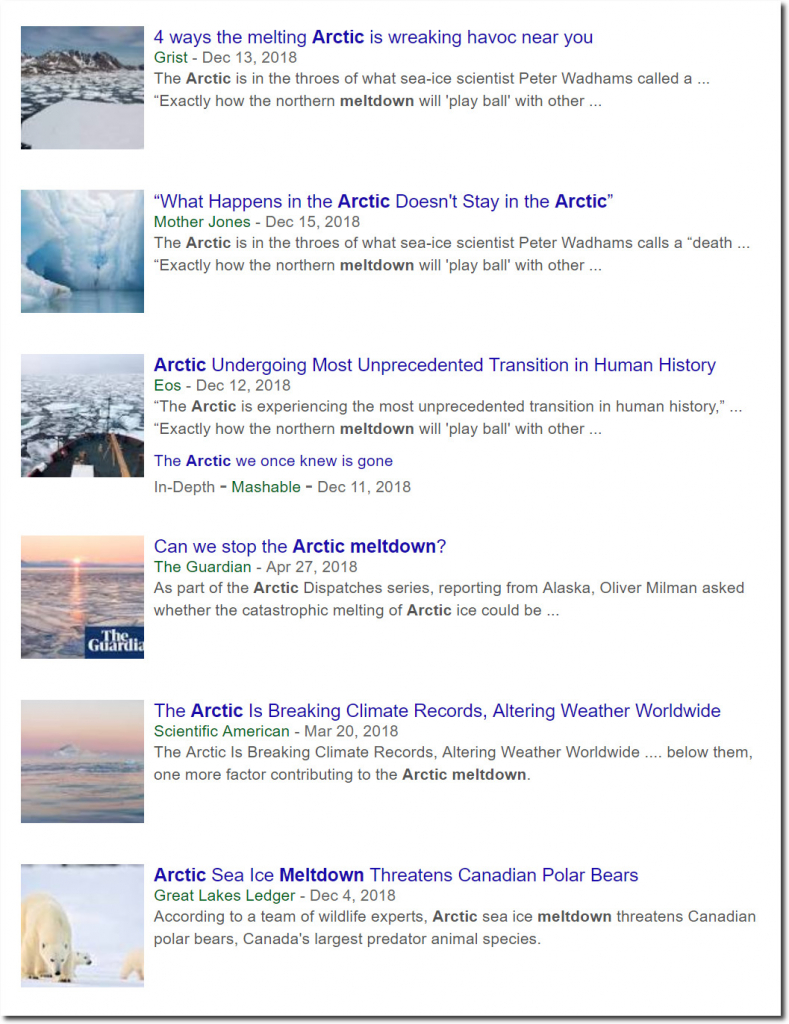
“Arctic meltdown” search
* Read the rest of this entry »
GREAT BARRIER REEF SCIENTIST : Coral Can Take The Heat, Unlike ‘Experts’ Crying Wolf
Posted: December 26, 2018 | Author: Jamie Spry | Filed under: Alarmism Debunked, Alarmist media, Alarmists, Climate Alarmism, Climate science, Climatism, Coral Bleaching, Fact Check, Great Barrier Reef, State Of The Climate | Tags: ARC, Climate Change, Climate Change Funding, Climate Change Scam, Climatism, Global Warming, Global Warming Scam, Government Funding, Government grants, Great Barrier Reef, Great Barrier Reef Foundation, Professor Peter Ridd, Queensland, science, Science and Environment, Terry Hughes | 1 Comment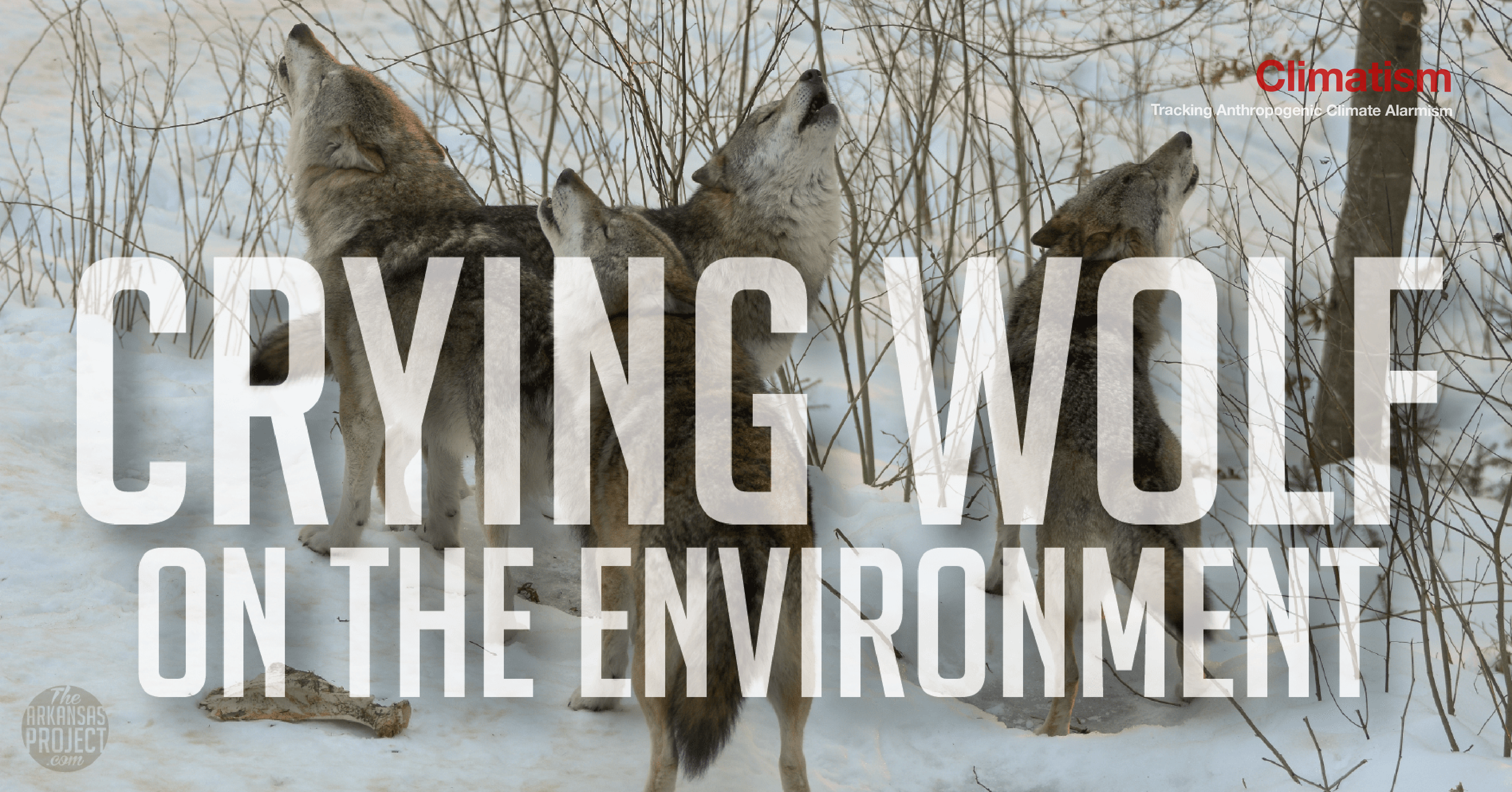
Crying Wolf : Great Barrier Reef Alarmism | CLIMATISM
“THE journalists come up and they’re not interested in what the truth is. They’re only interested in finding out where the ‘dead’ reef is. And when people who work right up and down the reef can’t actually take them to a single place that is going to suit their dooms-day story, then we sort of need a bit of balance…”
– Paul Talbott : GBR Tourist operator
***
STRAIGHT-TALKING former James Cook University marine geophysicist Professor Peter Ridd has been an outspoken critic of the relentless tide of fear-mongering, misinformation and anti-science hysteria advanced by climate change activists concerning the health of the Great Barrier Reef.
IN June of 2016, Ridd made the headlines after suspecting something was wrong with photographs being used to highlight the apparent rapid decline of the Great Barrier Reef:
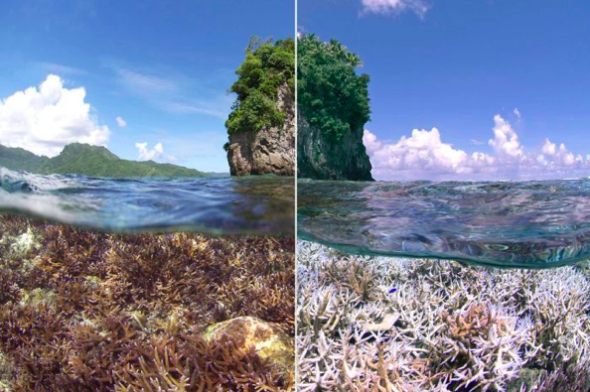
The ABC used a photo of reef bleaching on Flowerpot Rock in American Samoa in stories about the Great Barrier Reef.
AFTER attempting to blow the whistle on the bogus pictures, Ridd was censured and subsequently sacked by James Cook University. (Ridd is currently suing JCU)
After a formal investigation, Professor Ridd was found guilty of “failing to act in a collegial way and in the academic spirit of the institution”!
His crime was to encourage questioning of two of the nation’s leading reef institutions, the Centre of Excellence for Coral Studies and the Great Barrier Reef Marine Park Authority, on whether they knew that photographs they had published and claimed to show long-term collapse of reef health could be misleading and wrong.” Graham Lloyd – The Australian – 11 June 2016
SIMILAR totalitarian treatment was dished out by free-thinking James Cook University to the late and great Bob Carter, a former JCU adjunct Professor. Carter was a world renowned climate change expert and sceptic. His crime – speaking outside the permitted doctrine of global warming climate change.
*
PROFESSOR RIDD writes an ever insightful and eye-opening piece on the reef in today’s Australian.
RIDD comments on the recent backtracking by Scientists from James Cook University who just published a paper on the bleaching and death of corals on the Great Barrier Reef and were surprised that the death rate was less than they expected…
*
Coral can take the heat, unlike experts crying wolf
Scientists from James Cook University have just published a paper on the bleaching and death of corals on the Great Barrier Reef and were surprised that the death rate was less than they expected, because of the adaptability of corals to changing temperatures.
It appears as though they exaggerated their original claims and are quietly backtracking.
To misquote Oscar Wilde, to exaggerate once is a misfortune, to do it twice looks careless, but to do it repeatedly looks like unforgivable systemic unreliability by some of our major science organisations.
The very rapid adaptation of corals to high temperatures is a well-known phenomenon; besides, if you heat corals in a given year, they tend to be less susceptible in the future to overheating. This is why corals are one of the least likely species to be affected by climate change, irrespective of whether you believe the climate is changing by natural fluctuations or because of human influence.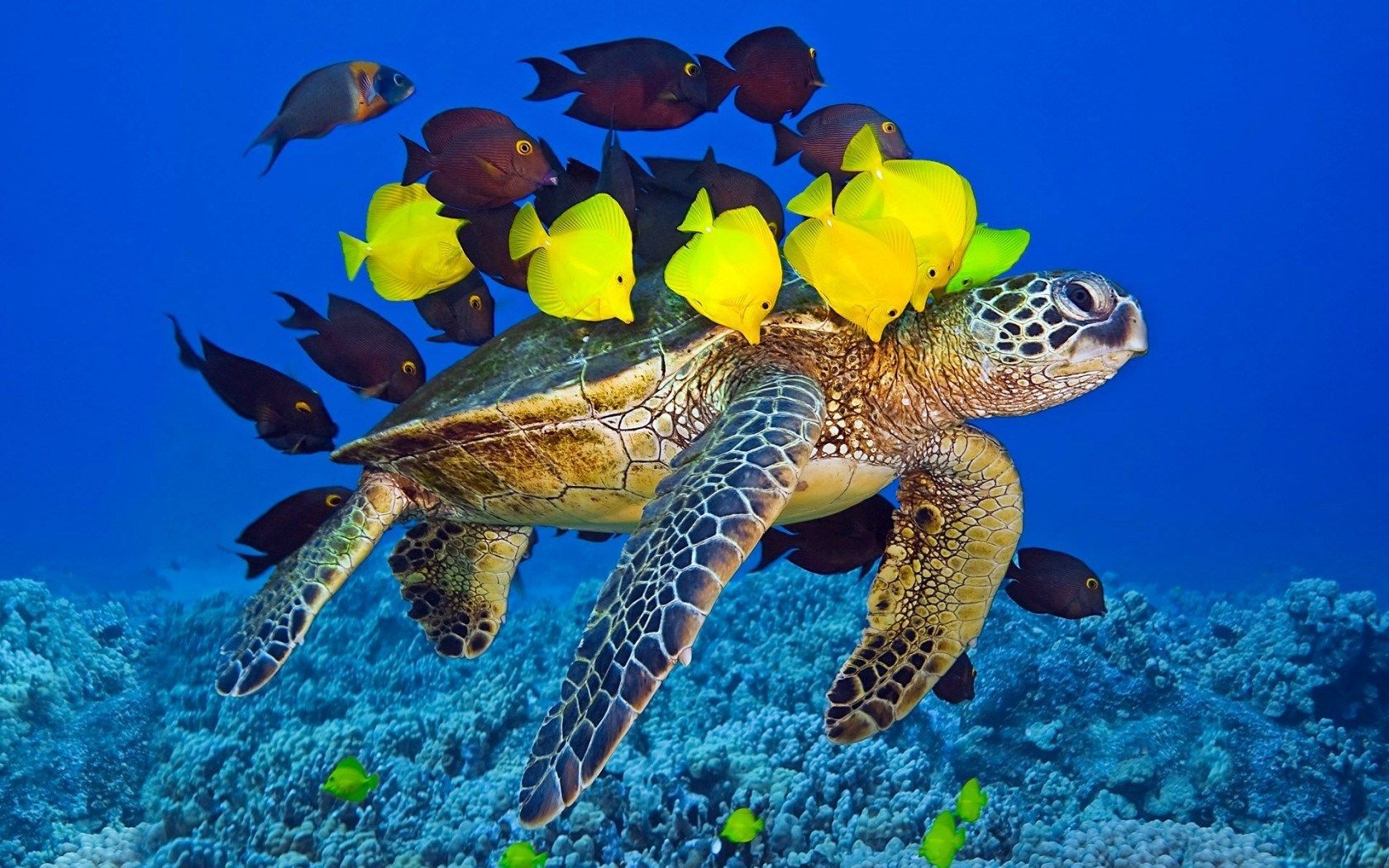
Corals have a unique way of dealing with changing temperature, by changing the microscopic plants that live inside them. These microscopic plants, called zooxanthellae, give the coral energy from the sun through photosynthesis in exchange for a comfortable home inside the coral. When the water gets hot, these little plants effectively become poisonous to the coral and the coral throws them out, which turns the coral white — that is, it bleaches.
But most of the time, the coral will recover from the bleaching. And here’s the trick: the corals take in new zooxanthellae, that floats around in the water quite naturally, and can selectselecting different species that are better suited to hot weather.
Most other organisms have to change their genetic make-up to deal with temperature changes — something that can take many generations. But corals can do it in a few weeks by just changing the plants that live in them.
They have learned a thing or two in a couple of hundred million years of evolution.
The problem here is that the world has been completely misled about the effects of bleaching by scientists who rarely mention the spectacular regrowth that occurs. For example, the 2016 bleaching event supposedly killed 93 per cent, or half, or 30 per cent of the reef, depending on which headline and scientist you want to believe.
However, the scientists looked only at coral in very shallow water — less than 2m below the surface — which is only a small fraction of all the coral, but by far the most susceptible to getting hot in the tropical sun. 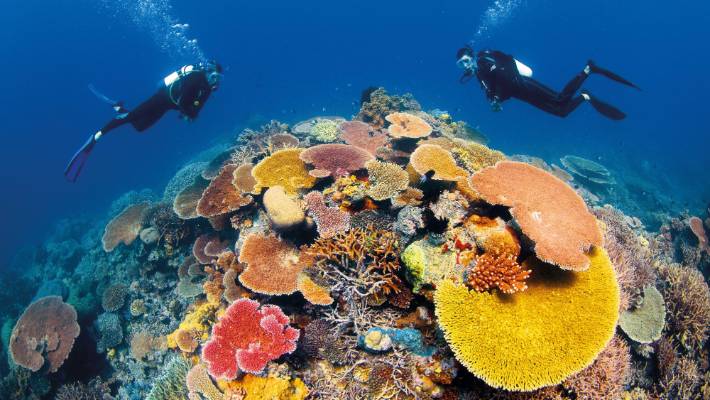
A recent study found that deep-water coral (down to more than 40m) underwent far less bleaching, as one would expect. I estimate that less than 8 per cent of the Barrier Reef coral died. That might still sound like a lot, but considering that there was a 250 per cent increase in coral between 2011 and 2016 for the entire southern zone, an 8 per cent decrease is nothing to worry about. Coral recovers fast.
But this is just the tip of the exaggeration iceberg. Some very eminent scientists claim that bleaching never happened before the 1980s and is entirely a man-made phenomenon. This was always a ridiculous proposition.
A recent study of 400-year-old corals has found that bleaching has always occurred and is no more common now than in the past. Scientists have also claimed that there has been a 15 per cent reduction in the growth rate of corals. However, some colleagues and I demonstrated that there were serious errors in their work and that, if anything, there has been a slight increase in the coral growth rate over the past 100 years.
This is what one would expect in a gently warming climate. Corals grow up to twice as fast in the hotter water of Papua New Guinea and the northern Barrier Reef than in the southern reef. I could quote many more examples.
This unreliability of the science is now a widely accepted scandal in many other areas of study and it has a name: the replication crisis. When checks are made to replicate or confirm scientific results, it is regularly found that about half have flaws. This is an incredible and scandalous situation, a view shared by the editors of eminent journals and many science institutions. A great deal of effort is going into fixing this problem, especially in the biomedical sciences, where it was first recognised.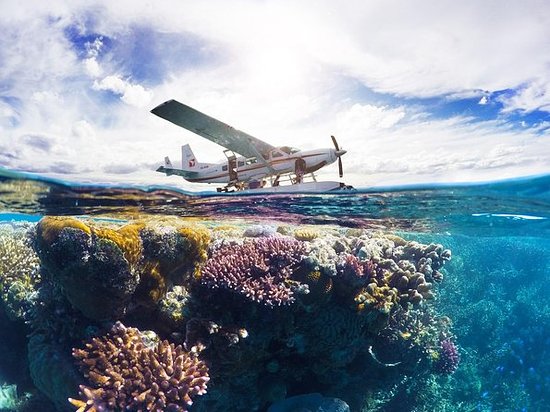
But not for Barrier Reef science. The science institutions deny there is a problem and fail to correct erroneous work. When Piers Larcombe and I submitted an article to a scientific journal suggesting we needed a little additional checking of Great Barrier Reef science, the response from many very eminent scientists was that there was no need. Everything was fine. I am not sure if this is blind optimism or wilful negligence, but why would anybody object to a little more checking? It would cost only a few million dollars — just a tiny fraction of what governments will be spending on the reef.
But the truth will out eventually. The scare stories about the Barrier Reef started in the 1960s, when scientists first started work on it. They have been crying wolf ever since. But the data keeps coming in and, yes, sometimes a great deal of coral dies in a spectacular manner, with accompanying media fanfare. It is like a bushfire on land — it looks terrible at first, but it quietly and rapidly grows back, ready for the scientists to peddle their story all over again.
Peter Ridd was, until fired this year, a physicist at James Cook University’s marine geophysical laboratory.
Coral can take the heat, unlike experts crying wolf | The Australian
•••
SEE also :
ALARMISTS U-TURN : Scientists Confirm Great Barrier Reef Is Recovering From Bleaching, Again
Posted: December 11, 2018 | Author: Jamie Spry | Filed under: Alarmism Debunked, Alarmism uncovered, Alarmist media, Alarmist Predictions, Australia, Climatism, Coral Bleaching, Government Grants/Funding, Great Barrier Reef | Tags: Alarmism Exposed, Climate Change, Climate Change Alarmism, COP24, Coral Bleaching, Global Warming, Global Warming Alarmism, Government grants, Govt Grants/Funding, Great Barrier Reef, Professor Peter Ridd, Reef Recovery, Science and Environment, Taxpayer waste, Terry Hughes | 5 Comments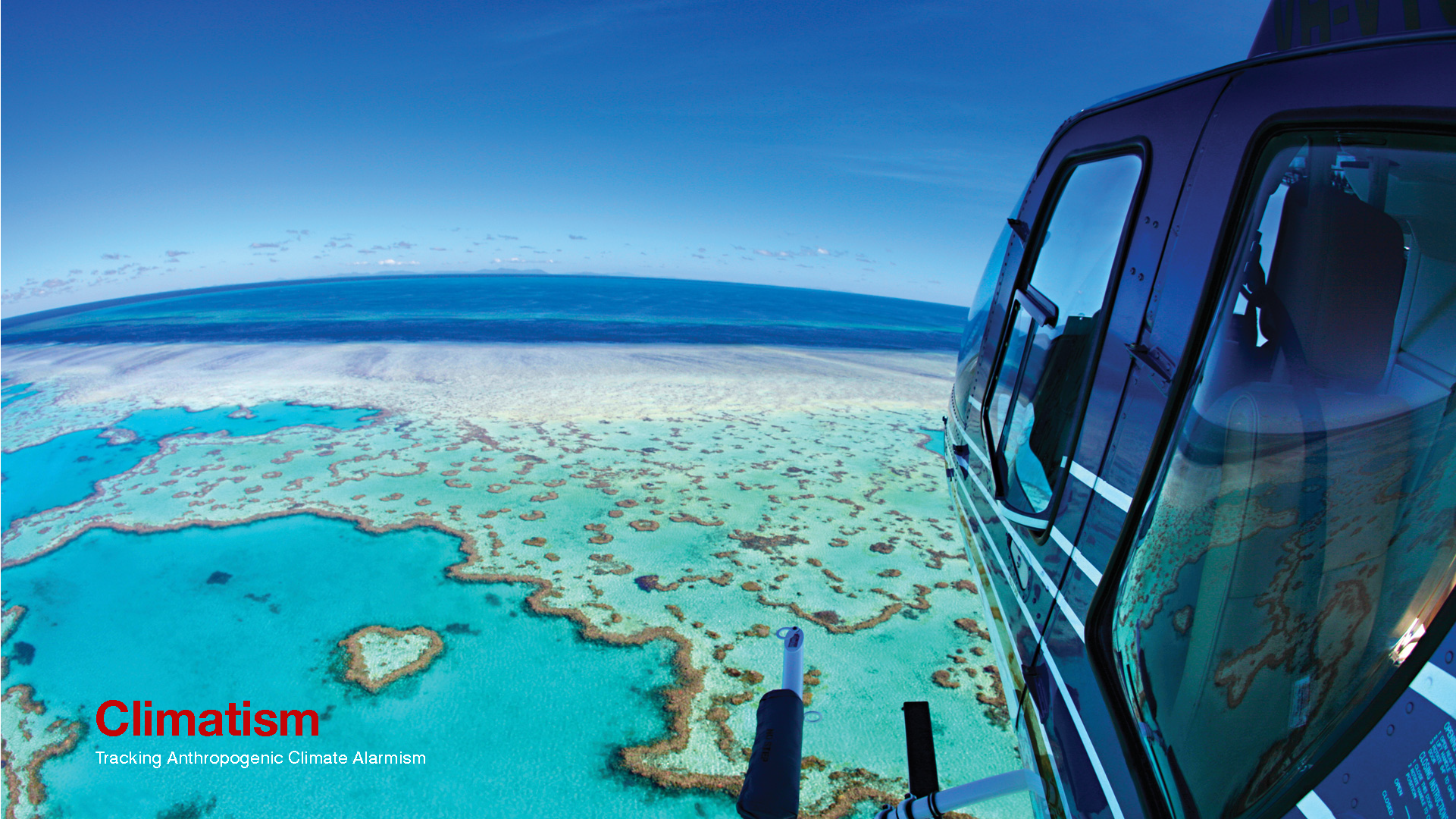
GREAT Barrier Reef Recovery – Climatism
“WE need to get some broad based support,
to capture the public’s imagination…
So we have to offer up scary scenarios,
make simplified, dramatic statements
and make little mention of any doubts…
Each of us has to decide what the right balance
is between being effective and being honest.“
– Prof. Stephen Schneider,
Stanford Professor of Climatology,
lead author of many IPCC reports
***
H/t GWPF
REMEMBER when climate ‘scientists’ said “Corals on Great Barrier Reef will never be the same after back-to-back heat waves“ …
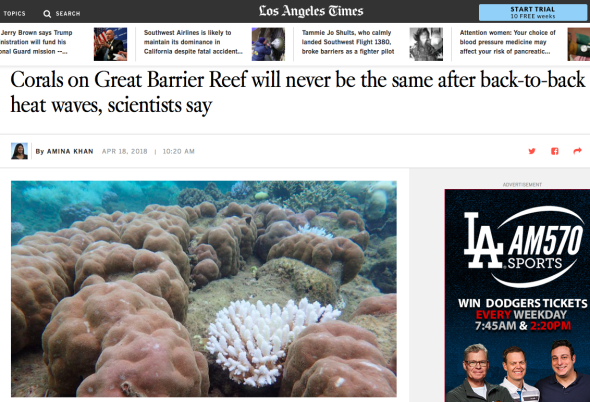
- Corals on Great Barrier Reef will never be the same after back-to-back heat waves, scientists say | LA Times
*
REMEMBER when climate ‘scientists’ said “Global warming has changed the Great Barrier Reef ‘forever’ …
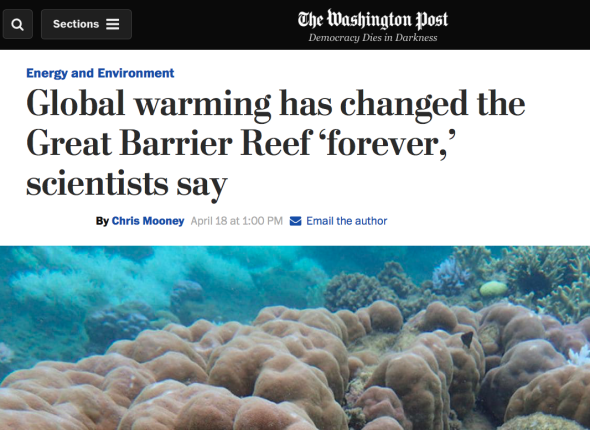
Global warming has changed the Great Barrier Reef ‘forever,’ scientists say | The Washington Post
*
REMEMBER when climate ‘scientists’ said “Great Barrier Reef is damaged beyond repair and can no longer be saved“ …

Great Barrier Reef is damaged beyond repair and can no longer be saved | The Telegraph
*
Never-mind …
GREAT BARRIER REEF RECOVERS (Again)
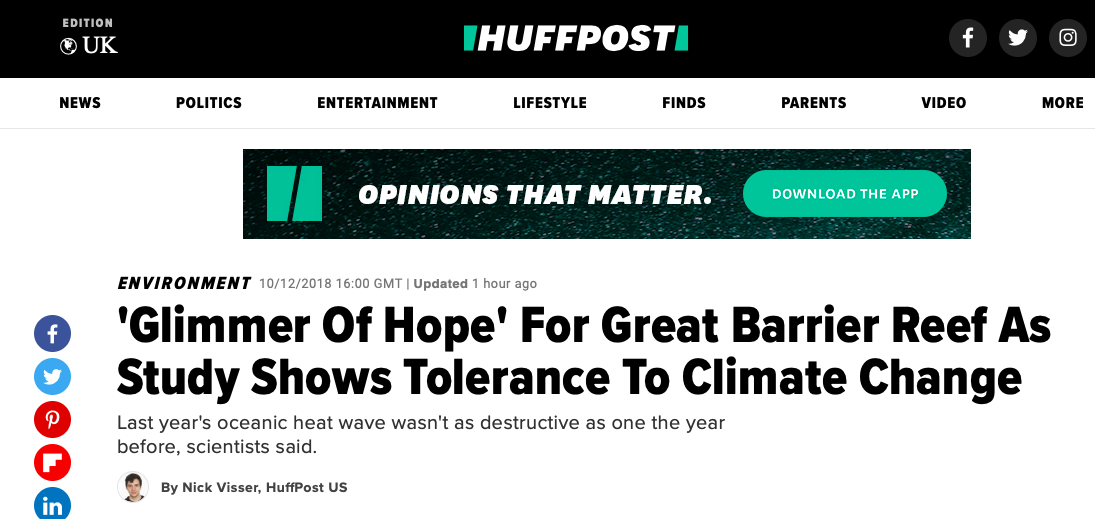
‘Glimmer Of Hope’ For Great Barrier Reef As Study Shows Tolerance To Climate Change | HuffPost UK
The Great Barrier Reef fared better during an oceanic heat wave last year than during sizzling weather a year earlier that caused hundreds of miles of corals to bleach, according to a study published Monday that suggests the massive structure may be growing more tolerant to climate change.
The report in the journal Nature Climate Change analyzed how corals along the Great Barrier fared in back-to-back mass bleaching events. The reef ― a UNESCO World Heritage Site and the largest living structure on the planet ― was cooked by overheated seawater in 2016 and again in 2017, with images of sickly white coral horrifying people around the globe.
During the first event, which scientists likened to an underwater apocalypse, almost 30 percent of the reef died.
But the second event last year, which saw seas even hotter than 2016 in many places, didn’t harm the reef as badly as scientists expected. They speculated that the structure may be going through a forced evolution that has helped toughen it, at least in part.
“The good news is the Barrier Reef glass is still half-full,” said Terry Hughes, a lead author of the study and the director of the ARC Centre of Excellence for Coral Reef Studies. “Whether we’ll still have reefs in 50 years time … there’s a glimmer of hope that we will.”
‘Glimmer Of Hope’ For Great Barrier Reef As Study Shows Tolerance To Climate Change | HuffPost UK
*
AMAZING how quickly $444 MILLION of taxpayers hard-earned money can ‘fix’ the reef. Or, do vast amounts of free cash help dial down the hysteria from the Climate Crisis Industry and CO2-obsessed reef ‘scientists’?

Malcolm Turnbull defends surprise $444 million Government donation to tiny reef body – Politics | ABC News
***
REEFS RECOVER (With or without $444 MILLION!)
DRAMATIC recovery of a remote reef off WA, after 1998 El Niño coral bleaching event:
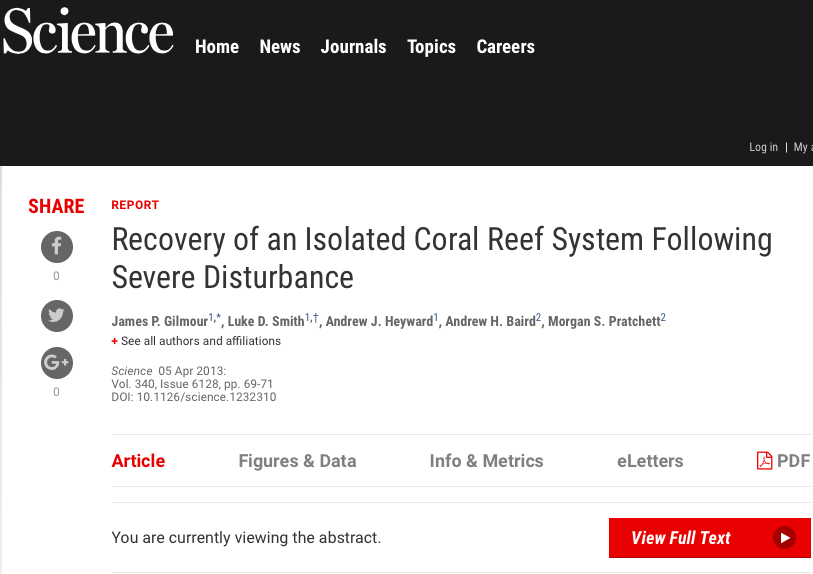
Recovery of an Isolated Coral Reef System Following Severe Disturbance | Science
From The Abstract :
Coral reef recovery from major disturbance is hypothesized to depend on the arrival of propagules from nearby undisturbed reefs. Therefore, reefs isolated by distance or current patterns are thought to be highly vulnerable to catastrophic disturbance. We found that on an isolated reef system in north Western Australia, coral cover increased from 9% to 44% within 12 years of a coral bleaching event, despite a 94% reduction in larval supply for 6 years after the bleaching. The initial increase in coral cover was the result of high rates of growth and survival of remnant colonies, followed by a rapid increase in juvenile recruitment as colonies matured. We show that isolated reefs can recover from major disturbance, and that the benefits of their isolation from chronic anthropogenic pressures can outweigh the costs of limited connectivity.
Recovery of an Isolated Coral Reef System Following Severe Disturbance
*
CORAL BLEACHING IS A NATURAL PHENOMENON & REEFS HAVE SURVIVED & THRIVED IN FAR HIGHER TEMPS & CO2 LEVELS IN THE PAST
CORALS evolved during the Cambrian era when atmospheric CO2 levels were at 6,000-7,000 ppm, around 4,000 percent or 20 times higher than today’s “CO2-starved” environment of 400 ppm, with atmospheric and ocean temps temps far higher than today.
THE world was hotter during the Holocene optimum, yet somehow the Great Barrier Reef survived.
CORAL reefs have survived millions of years of dramatic and sudden climate change, yet climate alarmists want us to believe that a few hundred ppm more of essential trace gas CO2 “has changed the Great Barrier Reef ‘forever,’ (Wapo)” or that even a “Great Barrier Reef recovery [is] unlikely after ‘catastrophic die-off’“?!
BLEACHING is a naturally occurring phenomenon essential to the health and regrowth of coral reefs.
THE “Great Barrier Reef” is only “Great” because it has died off at least 7 known times over the millennia.
*
DR TERRY HUGHES & THE POWER OF GRANT MONEY
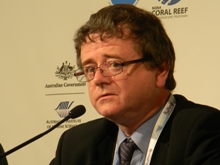
Dr Terry Hughes
Terry Hughes, is the director of the ARC Centre of Excellence for Coral Reef Studies at James Cook University, the same University who recently censured physicist at James Cook University Professor Peter Ridd who has dared to question scientific findings that purport to show the Great Barrier Reef is in trouble.
IN June 2017, Ridd made the headlines after suspecting something was wrong with photographs being used to highlight the apparent rapid decline of the Great Barrier Reef.
AFTER attempting to blow the whistle on the bogus pictures, Ridd was censured by James Cook University and threatened with the sack…

The ABC used a photo of reef bleaching on Flowerpot Rock in American Samoa in stories about the Great Barrier Reef.
ABC FAKE, FAKE NEWS…
SHAMEFUL Day For Australian Universities – Andrew Bolt
Posted: May 23, 2018 | Author: Jamie Spry | Filed under: Australia, Climate science, Communism, Ecofascism, Environmentalism, Government Grants/Funding, Great Barrier Reef, Green Agenda | Tags: Andrew Bolt, Cimate Change, Climate Change, Great Barrier Reef, JCU, Marxism, Professor Peter Ridd, pseudoscience, Science and Environment, Totalitarianism | Leave a commentSCIENTIFIC Marxism. The totalitarians at JCU destroying the meaning, value and relevance of ‘science’ in the name of global warming groupthink and government grants.
NOT A LOT OF PEOPLE KNOW THAT
By Paul Homewood
h/t Stewgreen

https://twitter.com/theboltreport/status/998508795385933824
Andrew Bolt has an excellent piece on the Peter Ridd sacking, well worth a watch.
As well as the specific issue here, he highlights that this is part of a much wider trend in Australian universities, recalling the sacking of Bob Carter for daring to question global warming dogma.
He could also have mentioned Murry Salby.
View original post
GREAT BARRIER REEF Hysteria : Exaggerated Claims And Blatant Falsehoods, Designed To Spread Fear And Belief In A Man-Made Climate Apocalypse
Posted: April 19, 2018 | Author: Jamie Spry | Filed under: Alarmism, Alarmism Debunked, Alarmism uncovered, Alarmist media, Australia, Climatism, Coral Bleaching, Empirical Evidence, Fact Check, Fake News, Flannery, Government Grants/Funding, Great Barrier Reef, Oceans, Propaganda, Pseudo-Science, Tim Flannery | Tags: ABC, Activist Media, Alarmism, Beast From The East, Climate Change, Climate science, Coral, Coral Bleaching, Fake News, Global Warming, Global Warming Alarmism, Government Funding, Government grants, Great Barrier Reef, James Cook Uni, JCU, Mainstream media, nature, Oceans, Polar Vortex, Professor Peter Ridd, Professor Terry Hughes, science, Science and Environment | 2 Comments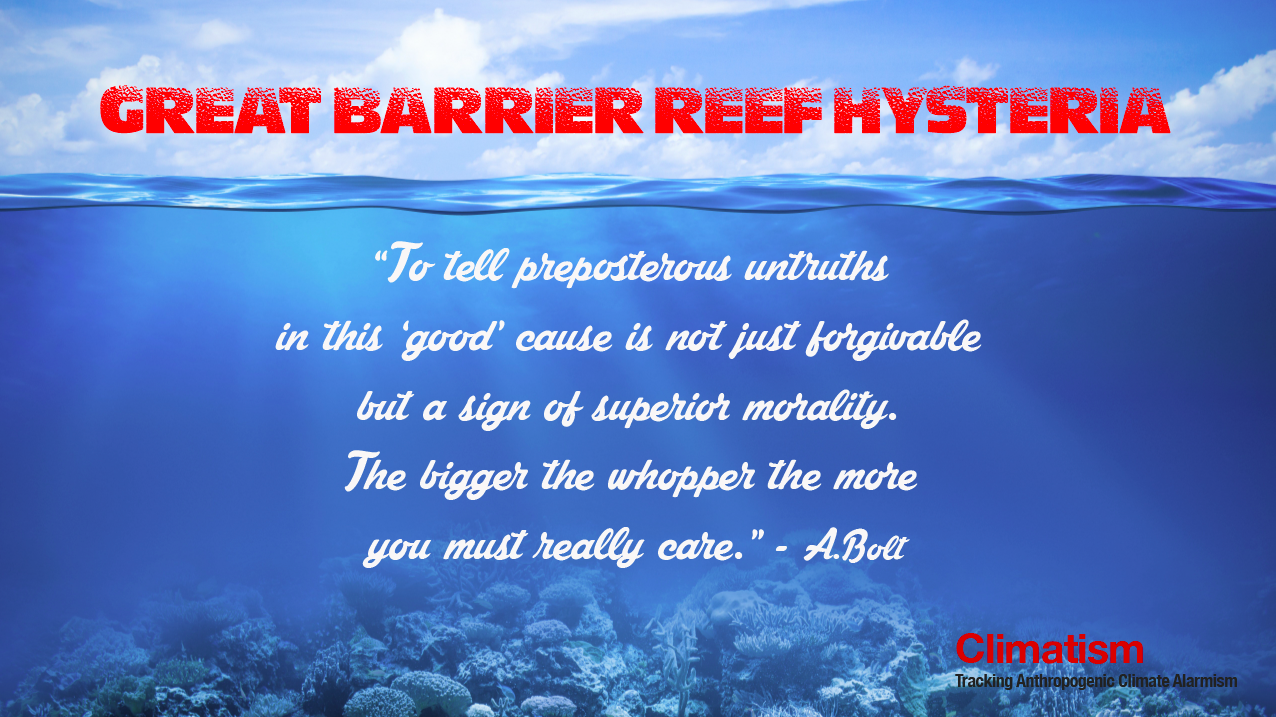
IT hasn’t been the best start to the year for the global warming doom industry. Three consecutive “Beast From The East’s“ caused by super-cold Arctic air have resulted in 48,000 non-heat related deaths in the UK alone, as the 2017/18 Northern Hemisphere mega-winter rages on, well into spring.
THE ‘extreme’ cold has seen Iguanas frozen solid in Florida, alligators in a state of cryogenic freeze, sharks washed up in Cape Cod “stranded due to cold shock”, the coldest Super Bowl on record, Niagara Falls frozen over, a thermometer in the world’s coldest village breaking as temperatures plunge to -62C, the lowest temperature ever recorded in Bangladesh, frozen crops creating a food crisis in Europe, even a mass die-off of sea creatures as UK ocean temps plunged 1-3 degrees centigrade, cold temperatures smashed across Saskatchewan’s central and south regions in the spring of April, and the list of non-heat ‘extremes’ goes on.
RECORD cold temperatures have dumped unprecedented amounts of the white fluffy stuff that was, by now, meant to be “a very rare and exciting event”, something that “Children just aren’t going to know what (snow) is”. Dr Viner’s “thing of the past” covered all 50 states in North America, with rare falls experienced in Rome, Monaco, the Sahara desert and the first snow in 50 years dusting Southern Morocco. And, it’s been a rough old winter for Gavin Schmidt’s NASA GISS Temp New York office – home of the “Hottest Year(s) Evah” sausage factory – with the city that never sleeps experiencing its “fifth consecutive season that at least 30 inches of snow has fallen” with CNN reporting “It’s official: NYC hasn’t seen snow like this in 130 years“!
DON’T LOOK THERE, LOOK HERE!
IN what appears to be another well-timed, and well-orchestrated plan to thaw out the inconvenient noise of the brutal NH winter still raging deep into Spring, the mainstream media, in concert with the climate crisis industry, has wheeled out an old favourite that always guarantees a juicy headline and an eco-emotional response – The “Death” of The Great Barrier Reef…
A new study, published in Nature by serial reef alarmist Prof Terry Hughes, Director of the ARC Centre of Excellence for Coral Reef Studies at James Cook University, examines the link between the level of heat exposure from the 2015/16 super El Niño, “resulting in coral bleaching and ultimately coral death.“

Global warming transforms coral reef assemblages | Nature
***
A TASTE of this morning’s mainstream media reef hysteria following the Hughes et al release: Read the rest of this entry »
THE Great Barrier Reef is thriving, not dying!
Posted: April 11, 2018 | Author: Jamie Spry | Filed under: Alarmism Debunked, Australia, Fake News, Great Barrier Reef | Tags: Activism, Alarmism, climate, Climate Change, Global Warming, Global Warming Scam, Global Warming Scare, Great Barrier Reef, nature, Scare Mongering | Leave a commentTHE real story on the current health of the Great Barrier Reef from dive-boat operators and divers who work up and down the reef everyday…
“THE journalists come up and they’re not interested in what the truth is. They’re only interested in finding out where the ‘dead’ reef is. And when people who work right up and down the reef can’t actually take them to a single place that is going to suit their dooms-day story, then we sort of need a bit of balance…”
Click to play…
The Great Barrier Reef is not dying! – YouTube
Green Jihad
During the middle of March, USA Today reported that a study published in the peer review journal Nature that coral reef growth stood to be severely harmed due to ocean acidification resulting from human-induced climate change. Researchers pointed to The Great Barrier Reef in Australia in their examination.
However, Paul Talbott at Majestic Aquariums in Australia explains why it’s important not to believe the hype.
View original post
CLAIM : World’s Coral Reefs Face New Peril From Beneath Within Decades
Posted: February 24, 2018 | Author: Jamie Spry | Filed under: Alarmism, Alarmism Debunked, Alarmist media, Alarmist Predictions, Australia, Carbon Dioxide, Climate Alarmism, Climatism, Coral Bleaching, Fact Check, Government Grants/Funding, Great Barrier Reef, Green Agenda, Ocean Acidification, Pseudo-Science | Tags: Activist Media, Alarmism, carbon dioxide emissions, Climate Change, Climatism, CO2, Coral Bleaching, Corals, environment, Fake News, Global Warming, Great Barrier Reef, IPCC, Ocean Acidification, Oceans, Peter Hannam, pseudoscience, Royal Society, Science and Environment, SMH, The Age | 3 Comments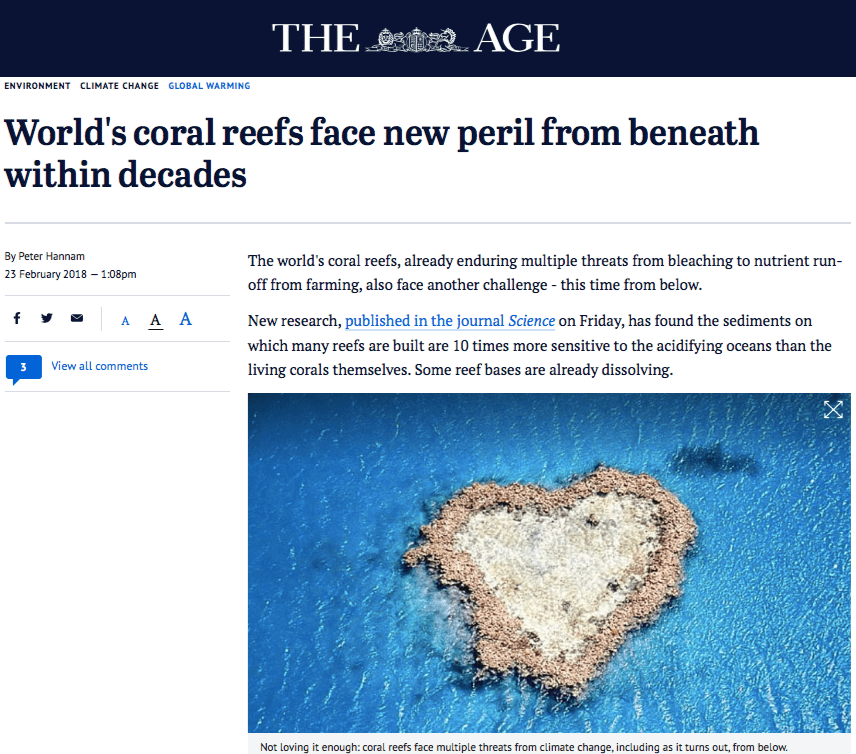
WITH a stubborn atmosphere failing to warm as predicted, another climate threat was needed to sustain the Climate Crisis industry and keep lazy reporters supplied with junk science to feed their catastrophic climate narrative. Enter “ocean acidification”!
FROM the onset, the term “ocean acidification” was deceptive by design. Oceans are alkaline. The correct ‘scientific’ term for any pH change toward zero is “less alkaline”. Obviously not the scariest of descriptors to shock the public into belief.
“Ocean Acidification” was first referenced in a peer-reviewed study in Nature in 2003, resulting in an explosion of journal articles, media reports and alarmist publications from environmental orgs. It has since gone viral, endorsed by scientists from numerous alarmist institutions including the Royal Society, the IPCC and NOAA who coined it “climate change’s evil twin” in a 2016 report.
A 2016 paper published in the ICES Journal of Marine Science put the issue of “ocean acidification” under the microscope, and found Scientists exaggerating the carbon dioxide threat to marine life…
Applying organized scepticism to ocean acidification research
“Ocean acidification” (OA), a change in seawater chemistry driven by increased uptake of atmospheric CO2 by the oceans, has probably been the most-studied single
topic in marine science in recent times. The majority of the literature on OA report negative effects of CO2 on organisms and conclude that OA will be detrimental to marine ecosystems. As is true across all of science, studies that report no effect of OA are typically more difficult to publish.
Excerpts from the paper:
Scientific or academic scepticism calls for critical scrutiny of research outputs before they are accepted as new knowledge (Merton, 1973).Duarte et al. (2014) stated that “…there is a perception that scientific skepticism has been abandoned or relaxed in many areas…” of marine science. They argue that OA is one such area, and conclude that there is, at best, weak evidence to support an OA-driven decline of calcifiers. Below, I raise some of the aspects of OA research to which I contend an insufficient level of organized scepticism has been applied (in some cases, also to the articles in this theme issue). I arrived at that conclusion after reading hundreds of articles on OA (including, to be fair, some that also raise these issues) and overseeing the peer-review process for the very large number of submissions to this themed issue. Importantly, and as Duarte et al. (2014) make clear, a retrospective application of scientific scepticism such as the one that follows could—and should—be applied to any piece of/body of research.
(Climatism bolds)
Applying organized scepticism to ocean acidification research | ICES Journal of Marine Science | Oxford Academic
From an article in The Times:
An “inherent bias” in scientific journals in favour of more calamitous predictions has excluded research showing that marine creatures are not damaged by ocean acidification, which is caused by the sea absorbing carbon dioxide from the atmosphere.
It has been dubbed the “evil twin of climate change” and hundreds of studies have claimed to show that it destroys coral reefs and other marine life by making it harder for them to develop shells or skeletons.
The review found that many studies had used flawed methods, subjecting marine creatures to sudden increases in carbon dioxide that would never be experienced in real life.
Dr Browman, who is also principal research scientist at the Norwegian Institute of Marine Research, found there had been huge increase in articles on ocean acidification in recent years, rising from five in 2005 to 600 last year.
He said that a handful of influential scientific journals and lobbying by international organisations had turned ocean acidification into a major issue.
“Such journals tend to publish doom and gloom stories . . . stated without equivocation,” he said. The bias in favour of doom-laden articles was partly the result of pressure on scientists to produce eye-catching work, he added.
“You won’t get a job unless you publish an article that is viewed as of significant importance to society. People often forget that scientists are people and have the same pressures on them and the same kind of human foibles. Some are driven by different things. They want to be prominent.”
(Climatism bolds)
Scientists‘ are exaggerating carbon threat to marine life | The Times
ENTER climate alarmist in chief – Peter Hannam – Environment Editor at The Sydney Morning Herald / The Age, with his latest doomsday report peppered with the same old regurgitated buzz lines designed to scare you into belief; “tipping points”, “pressure on governments globally to act”, “catastrophic destruction”, “mass bleaching”…
World’s coral reefs face new peril from beneath within decades
New research, published in the journal Science on Friday, has found the sediments on which many reefs are built are 10 times more sensitive to the acidifying oceans than the living corals themselves. Some reef bases are already dissolving.
—–
“Coral reef sediments around the world will trend towards dissolving when seawater reaches a tipping point in acidity – which is likely to occur well before the end of the century,” he said.

Not loving it enough: coral reefs face multiple threats from climate change, including as it turns out, from below.
At risk will be coral reef ecosystems that support tourism, fisheries and the many other human activities, he said.
The ocean’s acidity has increased about 30 per cent since the start of the industrial revolution, as seas absorb about one-third of the build-up of greenhouse gases in the atmosphere.
“It is vital that we put pressure on governments globally to act in concert to lower carbon dioxide emissions as this is the only way we can stop the oceans acidifying and dissolving our reefs,” Professor Eyre said.
Full article…
World’s coral reefs face new peril from beneath within decades | The Age
*
Notwithstanding the evidence owing to the inherent alarmism, exaggeration and journal bias of the OA scare, it might be useful for Hannam to consider this simple explanation of what goes on “beneath” the ocean surface…
Corals evolved during the Cambrian era with CO2 levels at 6,000-7,000 ppm, around 4,000% or 20 times higher than today’s “CO2-starved” environment of 400 ppm. Atmospheric and ocean temps were also far higher than today. Corals are made of Calcium Carbonate (CaCO3) – and could not exist without substantial amounts of CO2 in the atmosphere.
*
A sound explanation of the fallacy of ‘Ocean Acidification’ …
via JoanneNova.com.au
Thirdly, you raise the specter of what you bizarrely call ocean “acidification”.
The last time I looked, the oceans were pronouncedly alkaline, and even the mad IPCC says the acid-base balance has been altered by only 0.1 acid/base units in the direction of slightly reduced alkalinity. However, that estimate, like much else in the IPCC’s mad gospels, is entirely guesswork, because there is no sufficiently well-resolved global measurement program for ocean pH. However, elementary theoretical considerations would lead us to expect homoeostasis in the acid/base balance of the oceans because the buffering influence of the rock basins in which they live and move and have their being is overwhelmingly powerful. Acid/base neutrality is at a pH of 7.0. The oceans are at about 7.8-8.2 (no one knows, so that the IPCC’s alleged dealkalinization of 0.1 acid/base units is well within the measurement error, so that we cannot actually be sure that it has occurred at all; and, on the elementary ground I have described, it is unlikely to have done so). Besides, there is about 50 times as much CO2 already dissolved in the oceans than there is in the atmosphere, so that even if all of the CO2 in the atmosphere were to make its way into the oceans the pH would scarcely change even in the absence of the overwhelming buffering effect of the rocks. As for calcifying organisms, they are thriving. The calcite corals first achieved algal symbiosis and came into being 550 million years ago (you are too young to remember) during the Cambrian era, when atmospheric CO2 concentration was 25 times what it is today. The more delicate aragonite corals came into being 175 million years ago, during the Jurassic, when CO2 concentration was still 15 times today’s. “Ah,” you may say, “but it is the suddenness of the abrupt increase in CO2 concentration that the fragile corals will not be able to endure.” However, consider the great floods of the Brisbane River (eight of them from 1840-1900 and three of them since). The rainwater that pours into the ocean and meets the Great Barrier Reef is pronouncedly acid, at a pH of 5.4. Yet the corals do not curl up and die. “Ah,” you may say, “but what about the effect of sudden warming on the puir wee corals?” Well, the Great el Nino of 1997/8 gives us the answer to that one. Sudden increases in ocean temperature cause the corals to bleach. There have been two previous Great el Ninos in the past 300 years, and the corals bleached on both those occasions too. It is a natural defense mechanism against natural change. The corals continue to thrive. My brother and his three sport-mad boys dive on the reef every year and, like many others from whom I have heard, find the corals thriving except where the Crown of Thorns infestation has damaged small parts of the reef. Oh, and the Great Barrier Reef Authority, which has been moaning about the effects of rising sea temperatures on the corals, publish a dataset that shows zero increase in sea temperature in the region of the reef throughout the entire period of record. Don’t hold your breath worrying about ocean “acidification”: it can’t happen, even if all the CO2 in the air goes into the ocean.
Must See Also : Ocean Acidification is a Misnomer | Hawaii Reporter
OA SCIENCE
The Multiple Impacts of “Ocean Acidification” on a Tropical Coral
Reference
Takahashi, A. and Kurihara, H. 2013. Ocean acidification does not affect the physiology of the tropical coralAcropora digitifera during a 5-week experiment. Coral Reefs 32: 305-314.Background
The authors write that “according to the IPCC (2007) models, atmospheric CO2 is predicted to rise to 540-970 ppm by the end of this century and reach a maximum of approximately 1,900 ppm when the world’s fossil fuel reserves are fully exploited,” while noting that “a substantial number of laboratory studies have suggested a decline in coral calcification with a rise in seawater pCO2.” However, they say that recentstudies “have postulated that the sensitivity of corals to elevated levels of CO2 is potentially more diverse than previously considered,” citing the works of Fabricius et al. (2011), Pandolfi et al. (2011) and Rodolfo-Metalpa et al. (2011).What was done
Intrigued by these new and diverse findings, Takahashi and Kurihara measured the rates of calcification, respiration and photosynthesis of the tropical coral Acropora digitifera – along with the coral’s zooxanthellae density – under near-natural summertime temperature and sunlight conditions for a period of five weeks.What was learned
The two Japanese researchers found that these “key physiological parameters” were not affected by either predicted mid-range CO2 concentrations (pCO2 = 744 ppm, pH = 7.97, Ωarag = 2.6) or by high CO2concentrations (pCO2 = 2,142 ppm, pH = 7.56, Ωarag = 1.1) over the 35-day period of their experiment. In addition, they state that there was “no significant correlation between calcification rate and seawater aragonite saturation (Ωarag)” and “no evidence of CO2 impact on bleaching.”What it means
Contrary to what many climate alarmists have long contended, there is mounting evidence that suggests that the negative consequences they predict for the world’s marine life in a future high-CO2 world are by no means assured, nor are they likely to be widespread. Keep Reading »Source: CO2 Science
*
TOP footnote by Dellers
In the last decade or so, the climate change industry has become so vast and all encompassing, employing so many people, it simply cannot be allowed to fail.
According to a report last year by Climate Change Business Journal, it’s now worth an astonishing $1.5 trillion — about the same as the online shopping industry. If the scare goes away, then all bets are off, because the entire global decarbonisation business relies on it. The wind parks, the carbon sequestration projects, the solar farms, the biomass plantations — none of these green schemes make any kind of commercial sense unless you buy into the theory that anthropogenic CO2 is catastrophically warming the planet and that radical green measures, enforced by governmental regulation, must be adopted to avert it.
It’s no coincidence that the ocean acidification narrative began in the early 2000s — just as it was beginning to dawn on the climate alarmists that global temperatures weren’t going to plan. While CO2 levels were continuing to rise, temperatures weren’t. Hence the need for a fallback position — an environmental theory which would justify the massively expensive and disruptive ongoing decarbonisation programme so assiduously championed by politicians, scientists, green campaigners and anyone making money out of the renewables business. Ocean acidification fitted the bill perfectly.
Ocean acidification: yet another wobbly pillar of climate alarmism | The Spectator
•••
PLEASE Tip The Climatism Jar To Help Keep The Good Fight Alive! TQ…

•••
SEE also :
Related :
- Ocean acidification: yet another wobbly pillar of climate alarmism | The Spectator
- Forget the doom: coral reefs will bloom |The Australian
- Corals survived massive Caribbean climate change – likely to do so again | Climatism
- New publication demonstrates that scientists have routinely exaggerated the “evil twin of climate change” aka ocean acidification | Climatism
- The Ocean Is Not Getting Acidified | Watts Up With That?
- Patrick Moore: Ocean ‘Acidification’ Alarmsim in Perspective – JunkScience.com
- THE Great Global Warming “Pause” | Climatism




Recent Comments